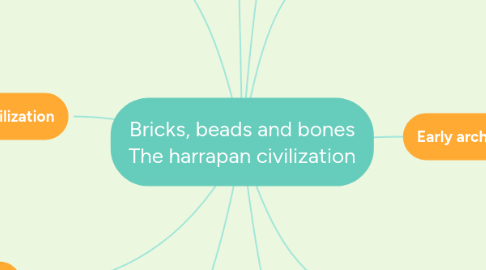Bricks, beads and bones The harrapan civilization
by AANCHAL RATHOUR


1. Period of Harappan civilization
1.1. The mature Harappan culture
1.1.1. 2600 BCE to 1900 BCE
1.2. The late Harappan culture
1.2.1. After 1900 BCE
1.3. The early Harappan culture
1.3.1. Before 2600 BCE
2. Tracking social differences
2.1. Burials
2.1.1. Dead were generally laid in pits
2.2. Studying Artefacts
2.2.1. Artefacts classified as utilitarian and luxuries
3. The end of civilization
3.1. Climate change
3.2. Deforestation
3.3. Excessive floods
3.4. Shifting and drying up of the rivers
3.5. Overuse of the land
4. Strategies for procuring materials
4.1. Materials from the sub continent and beyond
4.2. Contact with distant lands
5. Seals, script and weights
5.1. Seals and sealings
5.1.1. Used to faciliate trade
5.2. Weights
5.2.1. Made of stone called chert
5.3. An enigmatic script
5.3.1. Short scripts generally in the Form of symbols
6. Indus valley civilization_Harappan civilization
6.1. Largest bronze age civilization
6.2. First site to be discovered in this civilization
6.3. After 1900 BC sites were abandoned
7. Early archaeological cultures
7.1. Distinctive poetry
7.2. Evidence of agriculture
7.3. Pastrolism
7.4. Settlements were small in size
7.5. Had no buildings
8. The harrapan culture
8.1. Food availability
8.1.1. Wide range of plants and animals products ,fish
8.2. Subsistence strategies of the people
8.2.1. Animals, domesticated , farming and traces of canals have been found .
9. Finding about the past
9.1. Classifying finds
9.2. Problems of interpretation
10. Mohenjodaro
10.1. Town planning
10.1.1. Lower town
10.1.2. Citadel
10.1.3. Higher town
